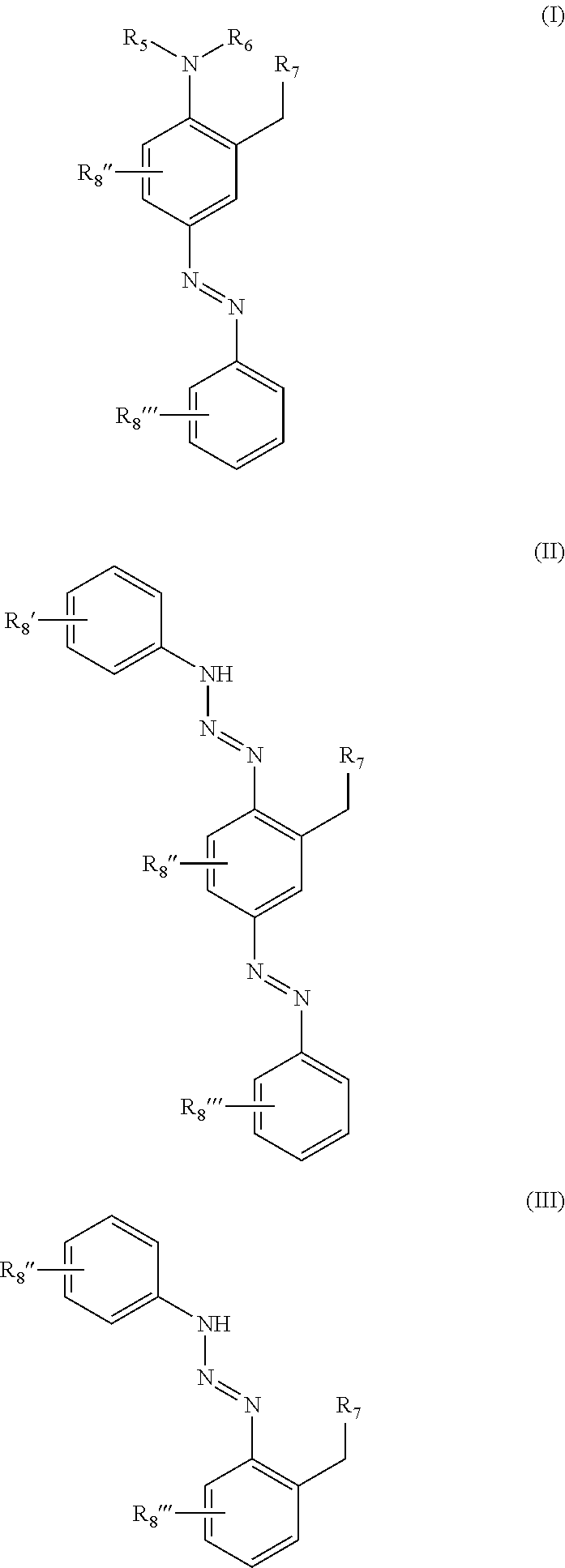Azo direct dyes and method for dyeing hair using these dyes
- Summary
- Abstract
- Description
- Claims
- Application Information
AI Technical Summary
Benefits of technology
Problems solved by technology
Method used
Image
Examples
example 1
2-(methoxymethyl)-4-{(E)-[2-(methoxymethyl)phenyl]diazenyl}aniline (Formula (1a))
[0096]
[0097]The compound according to formula (1a) has been obtained according to the following experimental protocol.
[0098]The following solutions have been prepared:
First Solution600g2-methoxymethylaniline1.2ln-butanol
Second Solution151gsodium nitrite7.5gacrylonitrile300mlwater
[0099]The second solution was added to the first solution over a time period of 3 min and 1.05 kg acetic acid was added to the first solution over a time period of 60 min. The first and the second solutions as well as the acetic acid had a temperature of about 0° C. The resulting mixture was stirred for further 60 min at a temperature of about 0° C. to 5° C.
[0100]2.10 kg of acetic acid was then added to the resulting mixture at a temperature of about 0° C. to 5° C. over a time period of 60 min. The reaction mixture was then stirred further over a time period of about 4 hours at a temperature of about 10° C. A mixture of 1.5 kg i...
example 2
(2-{(E)-[4-amino-3-(hydroxymethyl)-phenyl]diazenyl}-phenyl)methanol (Formula (1b))
[0102]
[0103]The compound according to formula (1b) has been obtained according to the following experimental protocol.
[0104]The following solutions have been prepared:
First Solution 5 g2-hydroxymethylaniline15 mLHydrogen chloride (25%)10 mLwater
Second Solution1.51gsodium nitrite0.075gacrylonitrile10mlwater
[0105]The second composition was added to the first composition over a time period of 30 min. The first and the second compositions had a temperature of about 0° C. 10.0 g sodium acetate was then added stepwise to the resulting mixture at a temperature of about 5° C. over a time period of 30 min. The resulting mixture was then stirred further over a time period of 30 min at a temperature of about 5° C. The precipitate was then filtrated and washed 3 times with 20.0 mL water and yielded 3.9 g of crude material.
[0106]The chemical shifts (indicated on the above formula) which are observed on the 1HNMR sp...
example 3
(2-{(2E)-3-[2-(methoxymethyl)-4-{(E)-[2-(methoxymethyl)-phenyl]diazenyl}phenyl]triaz-2-en-1-yl}phenyl)methanol (Formula (2a))
[0107]
[0108]The compound according to formula (2a) has been obtained according to the following experimental protocol.
[0109]The following solutions have been prepared:
First Solution1.0g2-methoxymethylaniline1mlwater2mlHydrogen chloride (25%)
Second Solution540 mgsodium nitrite 10 mlwater
Third Solution500 mg2-methoxymethylaniline 10 mlethanol
[0110]The second solution was added to the first solution over a time period of 3 min. The first and the second solutions had a temperature of about 0° C. The resulting mixture was stirred for further 60 min at a temperature of 0° C. to 5° C.
[0111]The third solution was added to the reaction mixture over a time period of 30 min at 0-5° C. The reaction was warmed up to room temperature and stirred for 120 min. A yellowish precipitate was formed, filtrated and dried. The powder was triturated with 4 ml of methanol, filtrated, ...
PUM
| Property | Measurement | Unit |
|---|---|---|
| time | aaaaa | aaaaa |
| time | aaaaa | aaaaa |
| temperature | aaaaa | aaaaa |
Abstract
Description
Claims
Application Information
 Login to View More
Login to View More - R&D
- Intellectual Property
- Life Sciences
- Materials
- Tech Scout
- Unparalleled Data Quality
- Higher Quality Content
- 60% Fewer Hallucinations
Browse by: Latest US Patents, China's latest patents, Technical Efficacy Thesaurus, Application Domain, Technology Topic, Popular Technical Reports.
© 2025 PatSnap. All rights reserved.Legal|Privacy policy|Modern Slavery Act Transparency Statement|Sitemap|About US| Contact US: help@patsnap.com



